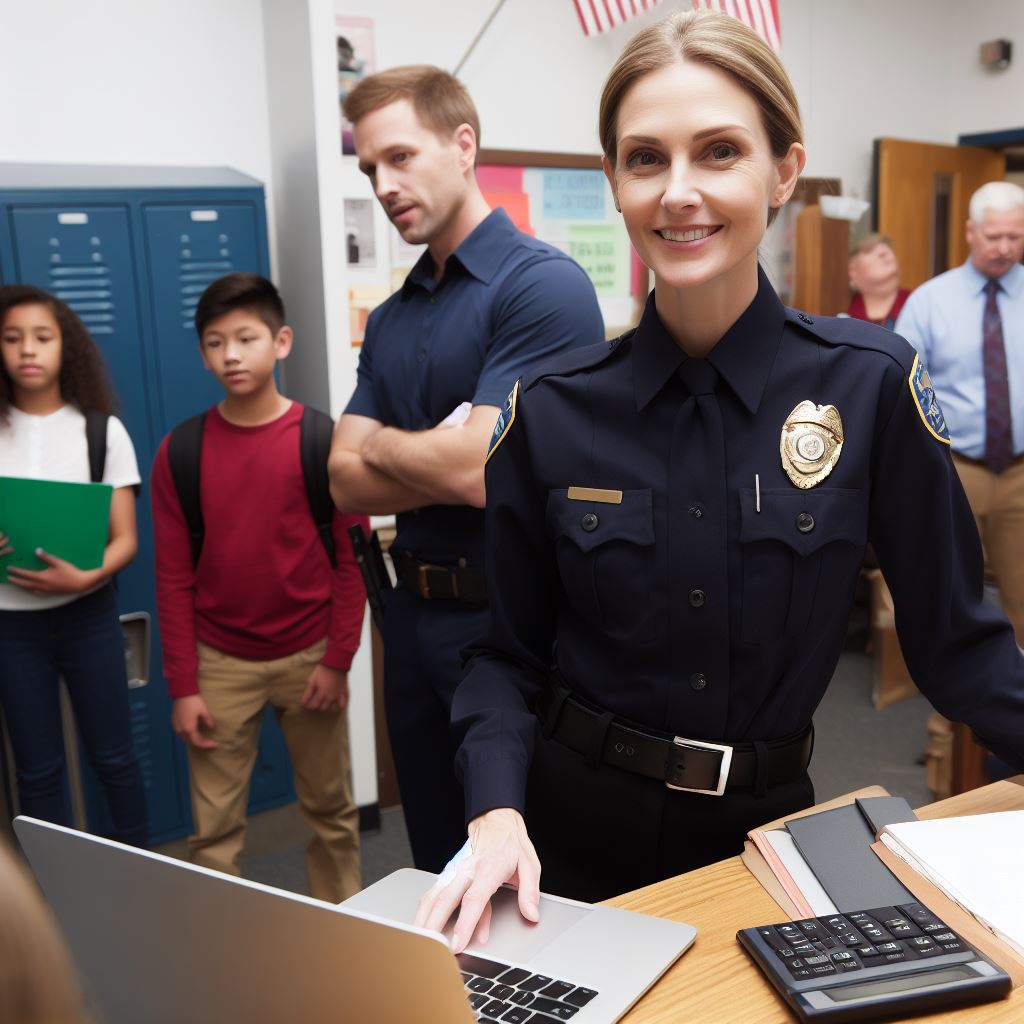Introduction
In today’s blog section, we will discuss the crucial role of administrators in implementing school safety protocols.
School safety is of utmost importance, and protocols must be in place to ensure the security and well-being of all students and staff.
Administrators play a vital role in overseeing and implementing these protocols effectively.
Firstly, let’s understand the significance of school safety protocols.
These protocols are designed to create a safe learning environment for students, free from any potential threats or harm.
They cover various aspects like emergency response plans, crisis management, evacuation procedures, and prevention of bullying and violence.
Now, let’s delve into the role of administrators in ensuring these protocols are followed.
Administrators are responsible for developing and maintaining a comprehensive safety plan that addresses all potential risks and emergencies.
They must work closely with faculty, staff, students, and parents to create a culture of safety and awareness within the school.
Administrators play a key role in training staff and students on safety procedures and protocols.
They organize regular drills and simulations to practice emergency responses, ensuring everyone knows their roles and responsibilities.
They also work closely with local law enforcement agencies and emergency responders to establish effective communication channels and coordinate efforts during emergencies.
Furthermore, administrators must regularly assess and update safety protocols to address changing risks and challenges.
They collaborate with relevant stakeholders to identify areas of improvement and implement necessary changes to enhance overall safety.
In fact, administrators hold a crucial position in ensuring the successful implementation of school safety protocols.
Their role involves creating a safe environment, training staff and students, collaborating with law enforcement, and continually improving protocols.
By prioritizing safety, administrators contribute significantly to the overall well-being of the school community.
Understanding School Safety Protocols
Definition of school safety protocols
School safety protocols refer to the comprehensive systems and procedures put in place to ensure the safety and security of students, faculty, and staff within a school environment.
Key components of effective protocols
Emergency response plans
An emergency response plan outlines the specific actions and procedures to be followed in the event of a crisis or emergency situation, such as natural disasters, violence, or threats to the school community.
Crisis management procedures
Crisis management procedures involve the strategies and steps taken to effectively handle a crisis situation, including communication protocols, decision-making processes, and the allocation of resources.
Physical security measures
Physical security measures encompass the physical infrastructure and devices implemented to protect the school premises, including surveillance cameras, access control systems, and secure building design.
Effective school safety protocols are crucial for creating a secure and nurturing learning environment for students.
By understanding and implementing these key components of effective protocols, administrators play a vital role in maintaining the safety and well-being of everyone within the school community.
Read: Exploring Career Growth Paths for School Administrators
The Administrator’s Responsibilities
As educational institutions continue to face safety concerns, the role of administrators in implementing effective school safety protocols becomes increasingly crucial.
Administrators have a wide range of responsibilities that encompass various aspects of safety and security within the school community.
Developing and implementing safety protocols
One of the primary responsibilities of administrators is to develop and implement safety protocols that provide comprehensive protection for students, staff, and visitors.
This involves collaboration with staff, parents, and community stakeholders to create measures that address the specific needs and challenges of the school environment.
Administrators work closely with staff members to gather input and expertise in order to design protocols that are practical and effective.
By involving the entire school community, administrators ensure that everyone has a voice and a role in ensuring a safe and secure environment.
Additionally, administrators conduct risk assessments and vulnerability analyses to identify areas where the school may be susceptible to safety threats.
By understanding potential risks, administrators can develop targeted strategies and allocate resources wisely to address these vulnerabilities.
Establishing clear policies and procedures is another key aspect of developing effective safety protocols.
Administrators create comprehensive guidelines that outline how emergencies should be handled, ensuring that staff members have a clear understanding of their roles and responsibilities during high-pressure situations.
These protocols help to maintain order and minimize confusion during critical incidents.
Training and educating school staff
In order to ensure the successful implementation of safety protocols, administrators are responsible for training and educating school staff members on emergency response procedures.
Training sessions are conducted regularly to familiarize staff with the necessary steps to take in the event of an emergency.
These training sessions cover a range of topics, including evacuation procedures, lockdown drills, and first aid techniques.
By providing comprehensive training, administrators equip staff members with the skills and knowledge necessary to respond effectively and protect students in emergency situations.
In addition to training sessions, administrators organize drills and simulations to practice emergency response procedures.
By simulating real-life scenarios, staff members can become more familiar with their roles and duties, allowing for a more efficient response during actual emergencies.
Transform Your Career Today
Unlock a personalized career strategy that drives real results. Get tailored advice and a roadmap designed just for you.
Start NowA crucial aspect of school safety is promoting awareness and vigilance among staff members.
Administrators actively encourage a culture of awareness, where staff members are attentive to their surroundings and play an active role in identifying and reporting potential threats.
Regular reminders and updates on safety protocols help to reinforce this culture of vigilance.
In essence, administrators play an essential role in ensuring the safety and security of schools.
Their responsibilities include developing and implementing safety protocols, collaborating with stakeholders, conducting risk assessments, and training staff.
By actively fulfilling these duties, administrators create a safe and secure learning environment for students and staff alike.
Read: Handling Parent & Teacher Conflicts: Best Practices

Enhancing Communication and Coordination
In order to enhance school safety protocols, administrators play a crucial role in enhancing communication and coordination.
By coordinating efforts with other administrators and building partnerships with law enforcement and emergency personnel, administrators can create a more secure and prepared school environment.
Coordinating efforts with other administrators
One way administrators can enhance school safety protocols is by coordinating their efforts with other administrators.
Regular meetings and update sessions serve as opportunities to share information, discuss challenges, and ensure everyone is on the same page.
This coordination helps in identifying and addressing any gaps or weaknesses within the safety protocols.
Furthermore, administrators can benefit from sharing best practices and lessons learned.
By discussing successful strategies and experiences, administrators can gain valuable insights that can be applied to their own schools.
This exchange of knowledge not only improves school safety protocols, but also fosters a sense of collaboration and community among administrators.
Partnerships with law enforcement and emergency personnel
Another important aspect of enhancing school safety protocols is building partnerships with law enforcement and emergency personnel.
These partnerships provide an invaluable resource in terms of expertise, guidance, and support.
Collaborating with these professionals is essential in developing comprehensive emergency response plans.
Administrators can work closely with law enforcement and emergency personnel to develop and refine their emergency response plans.
By sharing their knowledge and expertise, these professionals help ensure that the plans are effective and aligned with current best practices.
This collaboration also helps in identifying potential vulnerabilities and implementing proactive measures to mitigate risks.
In addition to planning, administrators should conduct joint exercises and trainings with law enforcement and emergency personnel.
These exercises simulate real-life scenarios and allow participants to practice response protocols in a controlled environment.
The feedback and insights gathered from these exercises help in identifying areas for improvement and refining the overall safety protocols.
In short, enhancing communication and coordination is crucial for administrators in improving school safety protocols.
By coordinating efforts with other administrators, sharing best practices, and building partnerships with law enforcement and emergency personnel, administrators can create a safer and more prepared school environment.
These collaborative efforts ultimately contribute to the overall safety and well-being of students, staff, and the entire school community.
Read: Promoting Diversity & Inclusion: An Admin’s Guide
Continuous Evaluation and Improvement
Continuous evaluation and improvement are crucial aspects of the administrator’s role in school safety protocols.
To ensure the effectiveness of safety measures and enhance the overall safety of the school environment, administrators need to assess and adapt their protocols continuously.
The effectiveness of safety measures:
1. Analyzing incident reports and response times
An essential step in evaluating the effectiveness of safety measures is analyzing incident reports and response times.
Administrators should review and analyze the details of each incident, including the effectiveness of the implemented safety protocols and the response time taken by staff members.
2. Gathering feedback from stakeholders
Stakeholder feedback is valuable in assessing the effectiveness of safety measures.
Administrators should actively seek input from staff, students, parents, and community members to identify areas of improvement and gather alternative perspectives on school safety.
3. Conducting safety audits and inspections
Regular safety audits and inspections are necessary to identify potential vulnerabilities and weaknesses in the school safety protocols.
Administrators should conduct comprehensive evaluations of the physical infrastructure, emergency systems, and safety procedures to ensure compliance and effectiveness.
Making necessary adjustments and improvements
1. Updating protocols based on evolving threats and risks
The safety landscape is constantly evolving, and administrators need to stay updated on the latest threats and risks.
It is crucial to regularly review and update safety protocols to address new challenges, emerging risks, and technological advancements that may impact the school’s safety measures.
2. Incorporating lessons learned from past incidents
Past incidents provide valuable learning opportunities.
Administrators should analyze past incidents, identify areas of improvement, and incorporate the lessons learned into revised safety protocols.
This proactive approach helps prevent future incidents and ensures continuous improvement.
3. Ensuring a culture of safety and preparedness
Creating a culture of safety and preparedness is crucial for effective school safety protocols.
Administrators should foster a sense of responsibility and awareness among staff, students, and parents.
Regular drills, training sessions, and communication about safety measures contribute to a prepared and vigilant school community.
In a nutshell, continuous evaluation and improvement are paramount in the administrator’s role in school safety protocols.
By assessing the effectiveness of current measures, making necessary adjustments, and fostering a culture of safety, administrators ensure the ongoing safety of all individuals within the school environment.
Read: School Administrator Role in Community Engagement
Transform Your Career Today
Unlock a personalized career strategy that drives real results. Get tailored advice and a roadmap designed just for you.
Start NowConclusion
Recap of the Administrator’s Role in School Safety Protocols
- Administrators are responsible for developing, implementing, and maintaining school safety protocols.
- They must lead safety drills and ensure staff and students are familiar with emergency procedures.
- Administrators coordinate with law enforcement and emergency services for effective response plans.
- Regular safety audits and risk assessments are essential to identify and mitigate potential hazards.
- Communication is key – administrators should keep all stakeholders informed about safety measures.
The Importance of Ongoing Commitment to Safety Efforts
- Safety is not a one-time effort; administrators must continuously update protocols and training.
- Staying informed about emerging threats and technology is crucial to adapt security measures.
- Collaborative efforts with staff, parents, and students foster a safer school environment.
- An unwavering commitment to safety ensures that schools remain secure and nurturing spaces for learning.




